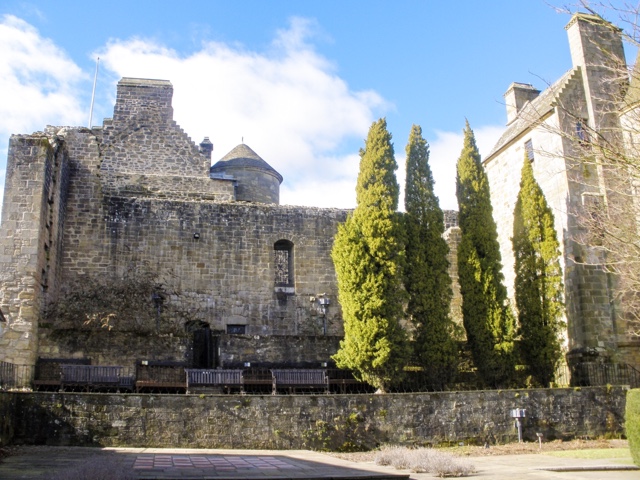Situated at the foot of the Lomond Hills of Fife, Falkland Palace was originally used as a hunting lodge. Prior to the construction of the palace, a hunting lodge existed on the site in the 12th Century. By the 13th Century the lodge had been expanded and became a castle owned by the Earl of Fife. A great wood of oaks existed between the royal stables and the River Eden. Parklands, groves, meadows and orchards surrounded the castle. In 1371 the castle was destroyed by an invading English army.
The Duke of Albany, Robert Stewart, the younger son of Richard II, chose to make the castle his home. He was appointed the Guardian of Scotland by his father in preference to his elder brother John. Despite this, John became King Richard III. As he suffered ailing health his younger brother Robert maintained a tight control over the kingdom.
In 1402, the twenty four year old son of Robert III, David Stewart, was imprisoned by his uncle in Falkland Palace. He was probably starved to death. James, the youngest son of Robert III, fled Scotland, only to be captured by English pirates, some believe after receiving a tip off from his uncle.
Robert, Duke of Albany retained power until his death in 1420. In 1424 James returned from captivity and after executing Murdoch, the 2nd Duke of Albany, Robert Stewart's son, he took over Falkland Palace.
The palace became a country retreat for the Stewarts. Falconry was practiced and deer were hunted. A large pond was used for fishing. Wild boars were imported from France and let free to roam in the fenced royal gardens.
Between 1501 and 1541 Kings James IV and James V transformed the old castle into a beautiful palace. The south range of the Palace was built and the buildings were extended in French Renaissance style. James V built a Royal Tennis Court, now the oldest tennis court in the world. James V died from apparent shock caused by the loss by his army at Solway Moss and his wife producing a female heir, Mary, later to be known as Queen of Scots. Queen Mary loved Falkland Palace and it is documented that she caused a commotion when she played tennis on the Royal Tennis Court in men's breeches.
An accidental fire in 1654, caused by Oliver Cromwell's troops, destroyed much of Falkland Palace.
In 1887 John Crichton-Stuart, 3rd Marquess of Bute, purchased Falkland Palace. He rebuilt much of the palace, completing work on the Gatehouse, the South Range and the Cross House, before his death in 1900 at the age of 53. Work continued on the palace and the gardens were enhanced. The addition of a Victorian Greenhouse to the grounds meant that exotic plants and flowers could be grown. In 1903, celebrated garden designer, Percy Cane worked on the gardens.
In 1952 the Hereditary Keeper Major Michael Crichton-Stuart appointed the National Trust for Scotland as keepers of Falkland Palace.
The beautiful Tapestry Gallery in Falkland Palace displays the famed verdure tapestries, or garden tapestries, most commonly depicting garden foliage and most likely created in France. It is in this gallery that the ghost of a woman is said to wander. The woman is described by witnesses as having a grey glow about her. She is said to stand by the window of the gallery weeping. It's believed that she is waiting for her lover who went to battle and never returned.
When I visited Falkland Palace I was struck by its beauty but also the fact that the ill-fated Mary Queen of Scots had enjoyed the Palace and the sports its gardens had offered. She was said to have been happy there. The Palace is a beautiful piece of architecture which is surrounded by gorgeous gardens. The oldest Royal Tennis Court in the world is also there for visitors to see.


















Great photos! Thanks for sharing!
ReplyDeleteThe Rad Wife
Thank you Morgan !
ReplyDelete